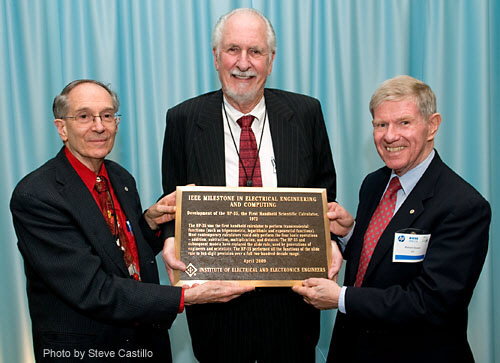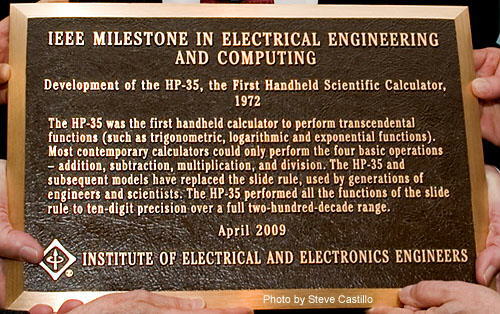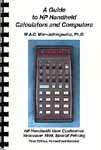

The HP-35 Calculator
The first electronic slide rule

From the book "A Guide to HP Handheld Calculators and Computers," by Wlodek Mier-Jedrzejowicz, Ph.D., available from Wilson/Barnett Publishing, P.O. Box 345, Tustin, CA 92781, USA. Also available through good book stores and Amazon.
Introduced on February 1 1972, the Hewlett-Packard HP-35 was the first handheld electronic calculator sold by HP, and the first handheld ever to perform logarithmic and trigonometric functions with one keystroke. In effect it was the world's first electronic slide rule. As opposed to later HP calculators, it has an xy function, not yx, and the trigonometric functions work in degrees only. It does not have a shift key like later models, but there is an ARC key for use with SIN, COS, and TAN to give their inverses. The story goes that it was made after William Hewlett was shown the HP9100 desktop calculator by his engineers, and asked for a version to fit in his shirt-pocket. At first, HP thought they would only make a few HP-35s for their own engineers, as no-one else would be interested. Then they decided to try selling it - and sold hundreds of thousands. The HP-35 is of special interest to collectors because it was the first HP handheld, and the world's first handheld calculator with transcendental functions, so I give more details of it than of other models.

Hewlett-Packard HP-35.
Developments
Several changes were made in the HP-35 design during the time it was made.
Two basic styles of prototype were designed - the simpler one was chosen for production. The other is reputed to have had gold trimmings - only a prototype case was made. Early publicity photographs show an HP-35 prototype, like the first production model shown on this guide's cover, but with the lettering on all the keys in black instead of white on some; black was used later on these keys on the HP-80 and the HP-45.
The earliest production HP-35 units had a small hole to the right of the on/off switch. When the HP-35 was turned on, a red spot showed through this hole. This was soon removed - you could see the HP-35 was on anyway, because the display lit up! Even if the batteries were low, you could see the switch was at the side marked ON. The "5" key had a raised dot on it so it could be found by touch. The first batches were made for use inside HP only - they have an (hp) logo printed inside the battery compartment. The serial number is printed on the back, between the two lower rubber feet, it is 1143A followed by the unit number stamped into the label in letters 1mm high. A batch of nearly identical HP-35s was made for a customer company who placed an order for them. Then the first HP-35s for general sale were made, still nearly the same, but with the unit number stamped in 3mm high digits.
I believe only about 10,000 of these "HP-35 with a hole" were made - but owners knew they had a collector's item, so they are nearly all still in existence. Ones in reasonable condition sell for at least $250 in the US - about £200 in the UK. One with its original plastic carrying box, leather case, AC charger, manual and stick-on "PROPERTY OF" labels can sell for $350 or more.
Once it became clear that the HP-35 was far more popular than had been expected, production was increased and a new design, without the hole by the on/off switch, and with the serial number inside the battery compartment, came into use. The first ones of this design still had serial numbers beginning with 1143A. The next set of serial numbers began with 1230A - showing that serial numbers of that time did not follow production dates closely. Early models of this new type still had the raised dot on the "5" key but later the dot was abandoned. At first the HP-35 was made only in the USA (at the Advanced Products Department in Cupertino - the calculator division moved subsequently to Corvallis) but production was soon moved to Singapore too, a standard HP practice; the first Singapore models also have serial numbers beginning with 1143S. HP-35 production in Singapore was run by Keng Joo Khaw, who is now the head of the whole Asia Pacific Personal Computer Division and therefore in overall charge of HP handhelds.
This version is far more common than the first one - it sells for $80 or more among collectors, or £80 in the UK.
So long as the HP-35 was the only handheld calculator made by HP, there was no need to put the model number on it; the label below the keyboard just said "HEWLETT-PACKARD". The success of the HP-35 led HP to introduce the HP-80, the first business model, and a model number on the label became necessary. The design was not changed, but a different label was placed below the keys, saying "HEWLETT-PACKARD 35". The difference between this version and the one above is small - indeed I would call them "varieties" rather than "versions" - and the price among collectors is similar to that for the version above.
All HP-35s have the numeric digits; pi; the addition, subtraction, multiplication, and division operations; and ENTER printed on the keys, but at first the other operations were printed above their keys, on the keyboard. Later models have the other functions printed on the keys as well. The function keys are horizontal rectangles on this version, not square buttons, and the trigonometric function keys are the same colour as the others. Later models also have the words OFF and ON moulded into the keyboard, not printed on it next to the on/off key. True HP-35 zealots will point out that these later models also had one silver-painted bar below the display, not two; see the section on versions and varieties below.
This later version is less common, though not as rare as the first one. It sells for about $100 or £90.
Early HP-35s had some errors - bugs! A bug in ex meant that typing: "2.02 ln ex" gives the result 2. instead of 2.02 but this was soon removed - indeed HP sent a recall notice to owners of early HP-35 units to get this fixed. An early HP-35 with this bug is worth more to a collector than one without! Another bug is that the sine of some small angles comes out completely wrong - this was dealt with after the other bug, so later versions have neither bug.
At introduction, the price was $395. This was reduced several times, and was $195 when the HP-35 was discontinued in February 1975.
HP-35 or HP-35A?
The HP-35 is often called the HP-35A. When HP began to add letters to calculator model numbers, they put the letter A after some model numbers that originally had no letter. This makes the model numbering scheme more uniform, but is not really necessary. In this guide, the original model numbers are used - that way no collector who already has an HP-35 or an HP-22 or any other unlettered model will begin looking for an HP-35A or an HP-22A - some manufacturers, notably TI, do have different models with and without an "A".
The first generation - transcendental functions
The HP-35 is sometimes described as the first model of the first generation of HP scientific handheld calculators. The second generation is reckoned to begin with the HP-65 which was the first programmable model. The third generation begins with the HP-28C which was the first to allow symbolic calculations. The innovation of the HP-35 is that it was the first handheld able to calculate transcendental functions. These are functions such as trigonometric and logarithmic functions, whose values cannot be worked out from a simple algebraic expression - they can only be worked out from an infinite series - they transcend algebra. The HP-35 and subsequent models use a method called the Cordic technique which rapidly calculates the value of a function by treating the calculation as a co-ordinate rotation. The June 1972 issue of the HP Journal describes this technique on pages 10 and 11, and provides other details of the HP-35 and references to further articles about the Cordic technique.
Families and Series
The success of the HP-35 - and competition from other companies - led HP to design more models, each with new or improved features. Eventually it became clear that whole series, or families, of models would need to be produced. The words "series" and "family" are generally used as if they mean the same in this context, though a "series" is usually a set of models all of the same size and shape, whereas a "family" can also be a set of models related in other ways, as was mentioned in section 1.3. The rest of this Chapter describes each series of HP calculators in a separate section, in historical order. Within each section there are general remarks on the whole family, followed by the individual calculators - the model number and the HP name for it are given, then a description, and in some cases a few notes on its features.
The Classic family — HP-35, HP-45, HP-55, HP-55, HP-65, HP-67, HP-70, HP-80
The success of the HP-35 led HP to introduce a business model, the HP-80, and then further models with the same basic design but with more and more features. These models came to be known as the "Classic family". The word "family" probably fits these classic models better than "series" because they are not all the same size and shape. The HP-35, HP-80, HP-45, HP-70 and HP-55 are 5.5 inches tall, 3 inches wide, and 1.2 inches thick at their widest (14.0 by 7.6 by 3.0 cm). The HP-65 and HP-67, which have a card reader built into them, are a little bigger, at 5.75 by 3.1 by 1.5 inches (14.8 by 7.8 by 3.3 cm). All measurements are at the maximum width and depth, and are approximate - taken with a ruler, not a micrometer - I apologise only for gross errors!
The HP-35 was so called because it had 35 keys - perhaps it was originally called the HP 35-key handheld calculator. The reasons for later model numbers are not quite so obvious. The second scientific model was called the HP-45 just to show that it was a significant advance on the HP-35 - 10 steps up! The third scientific model then became the HP-65 because it was even more of an advance on the HP-45 than that had been on the HP-35 - 20 steps up. The HP-55 then fitted in between the HP-45 and the HP-65; it had many improvements over the HP-45, but not as many as the HP-65, nor the same ones. The first business model was the HP-80 for no immediately obvious reason, but the second model was the HP-70, twice 35. Maybe the HP-80 was considered twice as good as the HP-35, and then 10 steps up! It is also possible that the HP-70 and the HP-80 were planned at the same time, with the HP-80 again "10 steps better", but that the HP-70 was introduced after the HP-80 instead of before it. The last model, the HP-67, has a model number which shows that it is an improved HP-65 - though the improvements were not trivial. (The number 67 also shows that this model was related to the HP-97, whose number was related to the general-purpose HP-27.)
Update April 2009:
Hewlett Packard awarded the "IEEE Milestone in Electrical Engineering and Computing" for the HP-35 calculator.
On April 14th 2009 Hewlett Packard announced that it had been awarded the prestigious "IEEE Milestone in Electrical Engineering and Computing" for the HP-35 calculator, the first hand-held scientific calculator.

Left to right presenting the IEEE HP-35 Milestone Award are: Lewis Terman (IEEE), Dave Cochran (HP-35), Richard Gowen (IEEE).

The press release explains:
"Introduced in 1972, the HP-35 was the world's first handheld-sized scientific calculator. An instant hit, the HP-35 ultimately made the slide rule, which had previously been used by generations of engineers and scientists, obsolete.
The HP-35, named for its 35 keys, was the first handheld calculator to perform transcendental functions such as trigonometric, logarithmic and exponential functions.
In the first three years after its introduction in 1972, sales of the HP-35 Scientific Calculator exceeded 300,000 units.
An IEEE Milestone plaque recording the award will be permanently displayed at HP Labs in Palo Alto, Calif., the site where the HP-35 was originally developed."
- The HP-35 is a featured hand-held calculator on this site, where there are more details and photographs of the calculator.
- The article "Purchasing an HP-35 Calculator in 1972", in the 'Collecting Calculators' section of this site, tells the story of one of the first students to purchase a Hewlett-Packard HP-35 scientific calculator.
There is further information on the HP-35 at the Museum of HP Calculators (including other photos of the HP-35).
A Guide to HP Handheld Calculators and Computers
Revised Guide to HP Calculators Available
The fifth edition of Wlodek Mier-Jedrzejowicz's "A Guide to HP Handheld Calculators and Computers" has been published.
Calculator Articles
Vintage Calculators
Text & photographs copyright, except where stated otherwise, © Nigel Tout 2000-2026.

